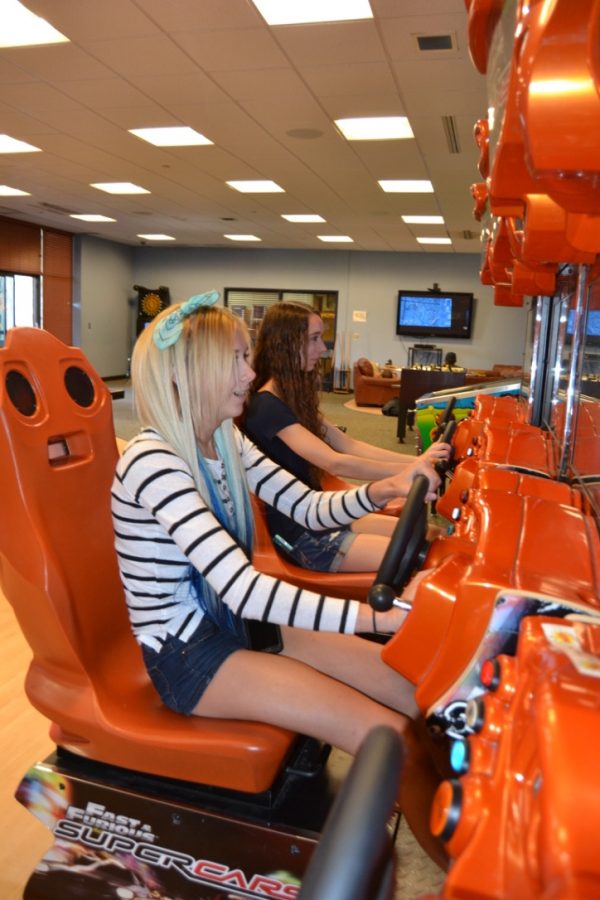Virtual reality coming to the Zone
Juniors Danielle Majetic (left) and Savannah Johns (right) race against each other on the Fast and Furious racing consoles in the Zone.
September 28, 2016
Virtual reality video gaming equipment is to be purchased for use in the Zone, the Student Union arcade.
According to Student Affairs Vice President Shawn Brooks, the original idea was advanced at a meeting last year by Pitt-Johnstown President Jem Spectar.
Brooks said that virtual reality video gaming was a familiar concept, but he was unsure of the specifics.
“(Spectar) asked me to look into it further because he thought (the idea) had a lot of potential,” Brooks said.
Though virtual reality video gaming may not be of interest to all students, Brooks said that not all students may enjoy the racing and shooting games in the arcade either.
Brooks said that he thinks, however, a larger percentage of students may be interested in virtual reality video gaming.
Brooks said that he thinks virtual reality video gaming has not become too mainstream yet, and Pitt-Johnstown would be on the cutting edge by providing students this gaming option in the Zone. He said that he does not know of any other college or university that has this equipment.
“What I really want to emphasize is that (Spectar) is constantly thinking about what we can do on this campus that is cutting edge and that will give students a good experience; this is one of many ideas on how to improve the campus,” Brooks said.
The equipment is to be purchased in parts that will be assembled to build the virtual reality video gaming system, which is cheaper than buying a prebuilt system, Brooks said.
“We have a lot of computer science majors (at Pitt-Johnstown) who would love to assemble the system,” Brooks said.
“They won’t be building a whole computer, just putting the component pieces together.”
Brooks said that he will be looking for student recommendations on who may be capable of building the equipment, regardless of major.
Another advantage to building a system, other than saving money, Brooks said, is the ability to add more features to the system in the future.
Some of the necessary gaming equipment includes computers and headsets, and students will be able to game individually or with friends, Brooks said. He said he is unsure, however, how many students may be able to game at one time.
According to Brooks, the virtual reality video gaming equipment is to be funded by auxiliary service money, which is neither tuition dollars nor student activity fee dollars.
“Everything from the bookstore, to dining services, to the housing program are all considered auxiliary money,” Brooks said.
“This money has always been used to fund the Zone in order for gaming to be free.”
Some of the car-racing games may also be removed from the arcade to further fund the virtual reality video gaming equipment, according to Brooks.
“I don’t think there’s a need to have eight machines; I rarely see people in a group of six or more using them at any one time,” Brooks said.
“By eliminating four, we are saving enough money to fund a vast majority, if not all, of the virtual reality video gaming equipment.”
Brooks said that no new money is being spent, rather, available money is being reallocated to fund this project.
To determine how many car-racing games may be removed from the arcade, Brooks said that maintenance workers from an outside company that installs and maintains the arcade games are to track how many times a machine has been used.
There is one running figure that shows how many times a machine has been played since purchased, he said.
When arcade maintenance workers check the machines, they tell Brooks the numbers.
Brooks said that the numbers on all of the car-racing games were just moderate, and that supports the decision to remove some of the machines.
“We’ll never remove the pinball machines, Brooks said.
“I want to continue to have as much of a variety of games as possible, and we will continue to offer traditional games, such as pinball, air hockey and pool.”
After the virtual reality video gaming equipment has been installed, Brooks said that student workers will be hired to work in the Zone.
These students do not have to be computer science students, but should be willing to learn about the equipment and teach others how to use it, he said.
“There will be a desk in the Zone for one student worker at a time, and they will check other students in and out using their student ID card if they wish to use the equipment.”
The equipment is not to be taken outside of the arcade, Brooks said; this procedure is to know who may be responsible if equipment is damaged, lost or stolen.
He said that the equipment will be locked away when no student worker is in the Zone.
Student Government Association President Kyle Maguire said that student government members have played a minimal role in this process.
“I heard of the idea, and I agreed that it was great to bring new and exciting technology onto campus,” he said.
“(The association), otherwise, has not voted or proposed anything regarding this change, and we do not plan to, either.”
Maguire said, however, that student government members plan to help advertise the new equipment and the building process in any way that Brooks needs.
Sophomore computer engineering major Eric Jennings said that he has used other virtual and augmented reality gear previously and enjoyed it.
He said that he likes the idea of bringing virtual reality video gaming equipment to the Zone.
“I think that students will be interested since many may have wanted to experience virtual reality gaming but cannot afford to purchase the necessary equipment,” Jennings said.
Jennings said that he would be interested in helping to assemble the equipment.
“While I do go to the arcade relatively frequently, I feel as though the virtual reality will be something that draws me there more often,” Jennings said.


